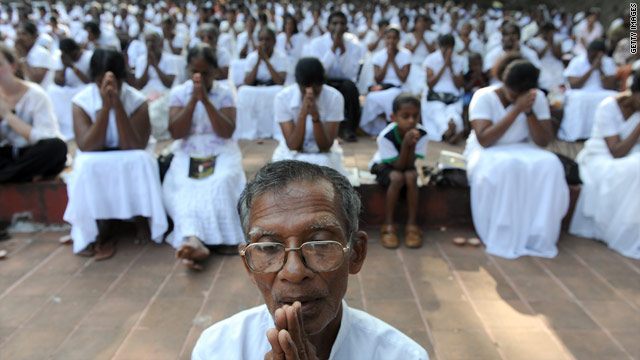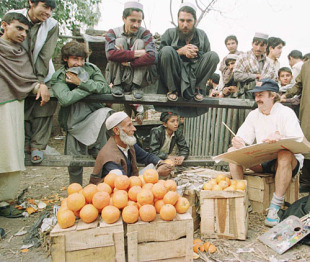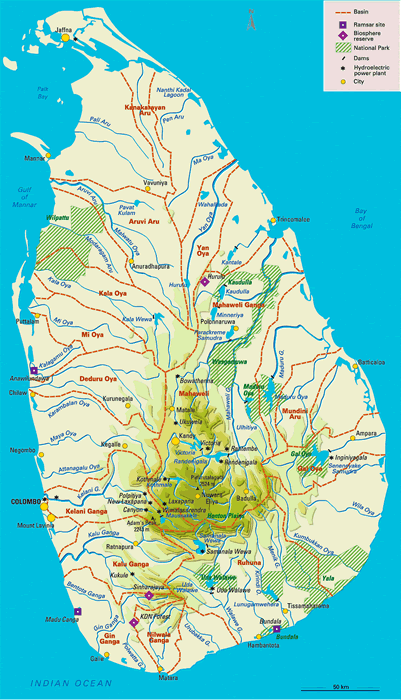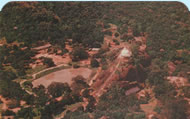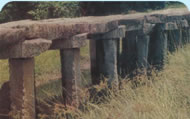Jan 28th 2010 | COLOMBO, HAMBANTOTA AND JAFFNA |
From The Economist
In a recent report, America’s Senate Foreign Relations Committee, recognising the damage American hectoring has done to its relations with Sri Lanka, also recommended a softer line. It noted Sri Lanka’s proximity to sensitive shipping lanes, and warned that “the United States cannot afford to ‘lose’ Sri Lanka.”
Indeed, that would be a shame for anyone. With its able people and natural bounties—including clement weather, verdant landscapes and fertile soil—Sri Lanka could almost be the paradise its travel agents describe. But that requires much better and kinder government. If Mr Rajapaksa, slayer of Tigers, could provide that, all Sri Lankans would praise him.

HAD Mahinda Rajapaksa, Sri Lanka’s war-winning leader, lost his island-state’s presidential election on January 26th, it would have been described as a Churchillian defeat. But that would have underdone the drama. Imagine Britain’s wartime prime minister falling out with his feted general, Montgomery, removing him, then losing to him in the 1945 general election. That is how victory for General Sarath Fonseka, Mr Rajapaksa’s main challenger, would have seemed.
Many predicted this. As army chief, General Fonseka oversaw the rout of Sri Lanka’s Tamil Tiger rebels in a sweeping offensive that ended a 26-year war in a seaside bloodbath last May. When he announced his candidature in November, opposition parties rallied behind him, including the biggest, Ranil Wickremesinghe’s United National Party (UNP). In campaigning, the rather wooden general and his backers gave voice to the serious gripes that Sri Lankans have with their government: economic hardship, after years of high inflation; rampant top-level corruption; and cronyism in a government that includes 109 ministers and allegedly hundreds of Mr Rajapaksa’s neighbours and relatives. But it mattered naught. Mr Rajapaksa won with 58% of the vote.
This included massive support from Sinhalese voters, members of Sri Lanka’s Buddhist majority. This was most marked in the south. In his native Hambantota district, a lovely southern expanse of paddies and tropical woodland, Mr Rajapaksa got 67% of the vote. His triumph also extended to coastal areas, where General Fonseka, a member of the Sinhalese fisher caste, had been expected to do well. In the general’s home town of Ambalangoda Mr Rajapaksa won with 63%. He also won in several strongholds of the parties that backed his rival. In the southern towns of Galle and Matara, turf of the Marxist Janatha Vimukthi Peramuna, Mr Rajapaksa got 64% of the vote.
General Fonseka—an American green-card holder, mendaciously accused by Mr Rajapaksa’s supporters of being a foreign plant—suffered embarrassment on polling day when it emerged that he was not registered to vote. Then it got worse. The general, a Sinhalese chauvinist, won almost exclusively in areas with many Tamils and Muslims. In the central Colombo district, for example, he won 76% of the vote. In Jaffna, the crumbling northern capital of Sri Lankan Tamils, who are 12% of the island’s 20m people, he won 64%—though with a low turnout, after hand-grenades were lobbed at several polling stations.
These results were expected. The biggest Tamil and Muslim political parties, the Tamil National Alliance (TNA) and the Sri Lanka Muslim Congress, both backed Mr Fonseka. Having no political party of his own, they reasoned, he could not do as much damage to them as Mr Rajapaksa has. The president, also a Sinhalese nationalist, with a fervent following among the country’s orange-robed right-wing Buddhist clergy, played the war’s endgame with a callous disregard for Tamil lives.
In a divided country, Mr Rajapaksa’s ruthless victory is the main reason the Sinhalese love him. “For the first time in my life, I can go to Colombo without wondering if I’ll make it back; I can send my children to school without wondering whether I’ll see them again,” said V.P. Anand, a small trader in the general’s hometown. Despite their troubles, it seems, most Sri Lankans were insufficiently unhappy to embrace General Fonseka. His political backers also made that difficult. The TNA was formerly controlled by the Tigers. And the UNP, during a ceasefire it brokered from 2002-06, sought an agreement with the rebels that would have given substantial autonomy to the mostly Tamil north and east. Sinhalese opposition to this proposal lives on: many Rajapaksa supporters noted that the general’s manifesto did not refer to Sri Lanka as a “unitary” state.
Fonseka forsaken
 In truth, the high expectations of General Fonseka had always looked exaggerated—a reflection of his strong support among influential city folk, including Colombo’s pro-UNP businessmen. Over lunch in Matara a few days before the poll Mr Rajapaksa accurately described this, while admitting that General Fonseka’s campaign had struck fear into his Sri Lanka Freedom Party (SLFP). In a voice feeble with speechifying, he said: “A week or two ago it looked too close to call, my people were very scared, there were lots of rumours. But I don’t think there’s a problem.”
In truth, the high expectations of General Fonseka had always looked exaggerated—a reflection of his strong support among influential city folk, including Colombo’s pro-UNP businessmen. Over lunch in Matara a few days before the poll Mr Rajapaksa accurately described this, while admitting that General Fonseka’s campaign had struck fear into his Sri Lanka Freedom Party (SLFP). In a voice feeble with speechifying, he said: “A week or two ago it looked too close to call, my people were very scared, there were lots of rumours. But I don’t think there’s a problem.”This was reasonable. Sky-high approval ratings had encouraged him to call this election fully two years before it was due. His party has won six consecutive provincial elections, mostly with similar majorities. Mr Rajapaksa had gutted the opposition to form a government, enticing a couple of dozen UNP and JVP parliamentarians to join his coalition. Until it found General Fonseka, it had been in disarray.
Far from the war wreckage in the north, some Sinhalese, albeit a minority, are enjoying a peace dividend. The economy, buffeted by a slump in garment exports and tourism because of the war, is perking up. This year the country is expected to see some 600,000 foreign tourists, compared with 500,000 last year. The New York Times has named Sri Lanka its top tourist destination for 2010. Annual remittances, mostly from hardworking Sri Lankans in Arab countries, have rebounded from a minor slump to around $3 billion. Last year the Sri Lankan stockmarket more than doubled in value, making it one of the best-performing in the world. Food prices remain punishingly high, yet inflation is down. The economy is expected to grow by around 6% this year.
Still, it is not in the character of Mr Rajapaksa’s authoritarian regime, which has terrorised the country’s once-vigorous independent media, to brook dissent. As expectations of a serious challenge from General Fonseka grew, the president’s campaign got ugly. State resources, including armies of public servants and over 1,000 buses, were dragooned into service. At least three unsupportive newspaper editors received death threats, and the star of a popular TV soap was sacked for declaring support for the general. Pro-Rajapaksa thugs tore down General Fonseka’s posters and beat up his campaigners. At least four people were killed.
On a pre-poll drive through Hambantota, almost every roadside wall was papered with the president’s image. The general’s was to be found only in tatters, in the vandalised ruins of one of his campaign offices. In Walasmulla village, an unemployed local youth said he had felt it necessary to volunteer for Mr Rajapaksa’s campaign in order to avoid suspicion—even though he intended to vote for the general. The reason? “No one gets a government job around here unless they’re with the family or can pay for it.”
Yet Mr Rajapaksa’s position is now formidable. His opponents are shattered. Parliamentary elections are due by May; in those, the SLFP and its allies will hope to win a majority and form a more stable government than the current one. That could be good. It would enable Mr Rajapaksa to cull half the current ministerial jobs. He could also bring in some long-promised constitutional changes, for which two-thirds parliamentary majorities are required. But since the most important would be to reduce the powers of his own office, it is by no means certain he will do this. Almost every Sri Lankan presidential candidate has sworn to return executive power to parliament since it was taken away in 1978. Mr Rajapaksa has now promised this in consecutive campaigns. His predecessor did the same.
War and peace
What Mr Rajapaksa means to do about Sri Lanka’s biggest problem, the ethnic division between Tamils and Sinhalese, is also uncertain. This, the root cause of a war that cost more than 100,000 lives, has not gone away with the Tigers’ demise. Yet there was no talk of reconciliation in this election—reflecting the sad fact that most Sinhalese do not consider it necessary. History suggests otherwise.
Almost since Ceylon, as Sri Lanka was then called, won independence in 1948, Tamils have suffered discrimination there. This included pogroms in the 1950s, 1970s and 1980s, and in 1956 a law to impose Sinhalese, which few Tamils then spoke, as the sole language of government. By the late 1970s Tamil intellectuals were clamouring for an independent Tamil homeland, or Eelam, in northern and eastern Sri Lanka, and Tamil militant groups were forming to fight for it. The Liberation Tigers of Tamil Eelam (LTTE), founded by Velupillai Prabhakaran with early support from India—which has over 60m Tamils of its own—was among them.
Prabhakaran, a textbook fascist, went on to murder his Tamil rivals, inspire love and terror in his followers and monopolise the Tamil nationalist cause. He has been credited with launching the first suicide-bombers, among whose thousands of victims were a former Indian prime minister, Rajiv Gandhi, in 1991 and a Sri Lankan president, Ranasinghe Premadasa, in 1993. Having wrested control of a swathe of northern and eastern Sri Lanka, the Tigers expelled thousands of Tamil-speaking Muslims and Sinhalese. The most able Tamils also fled, to Colombo, half of whose 670,000 population is Muslim or Tamil, and to Europe, Australia and America, where a quarter of Sri Lankan Tamils now live. In the way of expats, they grew even more radicalised in exile, raising millions of dollars a year for the LTTE.
Several governments sought to negotiate with the rebels, most recently that led by the UNP’s Mr Wickremesinghe. After first dropping his demand for separation, Prabhakaran sabotaged those talks, which he seemed to consider primarily an opportunity to rearm. Mr Rajapaksa, who was elected president in 2005 largely because the LTTE enforced a partial boycott of Tamil voters, took a harder line. With General Fonseka and his defence chief and brother, Gotabaya Rajapaksa, Mr Rajapaksa set about doubling the size of the army, to around 200,000 troops, and resumed the war. Their offensive, which began in the east, was ruthless and efficient. In late 2008 the army surged into Prabhakaran’s northern fief. After a terrible battle early last year, Mr Prabhakaran and almost all the LTTE’s commanders were annihilated.
It is hard to exaggerate the benefits of this. For the first time in most of their lives, Sri Lankans can board a bus with little fear it will explode. Tamils may also gain. Rid of the LTTE, they have an opportunity to find more moderate champions. Yet that is so important precisely because their grievances have not ended with Mr Rajapaksa’s victory. Indeed, given the government’s casual brutality towards them during the war’s last convulsions, these have multiplied. Over 8,000 Tamil civilians were killed on the final battlefield early last year. The survivors, some 300,000 inhabitants of the Tigers’ former lair, were until late last year interned in wretched camps. Journalists and aid workers were denied access to them, as the government mulled keeping them captive for a year or so. Under international pressure, it instead released them in a trickle and formally opened the camps in December. But 100,000 are still there, unable to return to their shattered homes until their fields are cleared of mines.
In Vavuniya, near the biggest camps, these folk traipse about in faded saris and sarongs. All have an awful tale—of a husband or children killed, or an aged parent missing. Krishnaswamy, a shopkeeper from Kilinochchi, the Tigers’ now-pulverised capital, says one of his sons and eight of his nephews and nieces were killed by the shelling; another son is missing. “Whoever comes to power, there will be no solution to our problem,” he says.
The parable of the fig tree
In Jaffna, which the army wrested from the LTTE in 1996, there are older grudges. The centre of an ancient Tamil civilisation—until the 1970s Indian scholars and medical tourists flocked to its library and clinics—it has suffered badly. Perhaps a quarter of the pre-war population of 750,000 has moved away. Thousands more Jaffnians live in wretched huts, their houses appropriated by the army for its garrisons. Hundreds of local youths have been murdered or “disappeared”. There have recently been improvements: the army’s checkpoints are being thinned, and there is also talk of some of the displaced going home. Yet Jaffna is seething.
In its central Madathadi area a local fisherman, Siluvithas, scowls at a fig tree that marks the site of a recently dismantled check-post. It was planted 13 years ago by Sinhalese soldiers, in whose Buddhist faith the tree is revered; most Tamils are Hindus. A golden Buddha is to be placed beside it. “First they plant the tree, then they put up a statue. Then they’ll build a temple and the Sinhalese will all move in,” said Siluvithas. The LTTE would never have allowed it, he says: “Without them, we are defenceless.”
Mr Rajapaksa has long promised a political solution to Tamil grievances. At best, this will be less than previous governments have offered. For example, under Mr Rajapaksa, the merging of Sri Lanka’s northern and eastern provinces, an important Tamil demand, has been reversed. But what the president has promised is not insignificant. He has vowed to implement a system of regional devolution that has existed on the statute book for over two decades, as well as to establish an upper house of parliament, which would increase the sway of Tamils and Muslims in Colombo. Such steps could go a long way to satisfying Tamil aspirations. Yet there are reasons to doubt Mr Rajapaksa’s willingness. A regional assembly set up in the east in 2008, and headed by an LTTE turncoat, is toothless and unloved. Asked whether he considered devolution important to mending Sri Lanka’s division, Mr Rajapaksa said: “Sri Lankans are not worried about these things, they are only for outsiders and NGOs with nothing better to think about. Sri Lankans want economic development…but a political solution is coming.”
For now, while so many Tamils are ruined and grieving, Mr Rajapaksa must be largely right. And with the economic reintegration of the country, Tamil demands for regional autonomy may weaken. Sri Lanka, with its growing private sector, can afford them an increasing array of opportunities. On a personal level, too, the spiteful racism that once expressed Sinhalese attitudes to Tamils is said to be less evident. But these are mere hopeful thoughts, falling far short of addressing Tamil concerns. Meaningful reform is required.
Tamils, a divided house, also need to unite—preferably also with Muslims. The two groups have much in common. Together they could form a powerful block. Otherwise, it is hard to see who could defend their interests—certainly not, as the wretched survivors of Mullaitivu beach know, Western governments.
Changing partners
Amid that slaughter, America, Britain and the rest all demanded that the government ease up to save civilian lives. Hillary Clinton, America’s secretary of state, accused it of causing “untold suffering”. In response, the army redoubled its assault. Mr Rajapaksa and his three cabinet-level brothers—two of whom are American citizens—considered America’s concerns at odds with the ruthlessness it has sometimes displayed in its own war on terror. But the government’s defiance, which seemed to signal an historic shift in Sri Lankan foreign policy, was also informed by a calculation that it did not need Western approval.
In recent years, as Western countries expressed their distaste for Mr Rajapaksa by imposing conditions on or cuts in their mostly puny aid to Sri Lanka, he has found allies elsewhere. Iran provided $450m for a power station, and a seven-month supply of oil on tick. Pakistan supplied Sri Lanka with arms for its final push, when America, among others, would not. So did China, which in 2008 overtook Japan as Sri Lanka’s biggest bilateral donor. It has provided over $1 billion in soft loans for an airport and port which Chinese workers are building in Hambantota—a potential haven, it would seem, for Chinese naval ships sent to guard the Indian Ocean sea-lanes. India, spooked by China’s rising interest in its near neighbour, has followed suit. It will extend loans of $700m to improve Sri Lanka’s railways. From a paltry base, its two-way trade with Sri Lanka is meanwhile surging: it was worth $3.9 billion in 2008.
Western countries have allowed Sri Lanka’s dire record on human rights to dominate their relations with the island largely because they consider it to be of little strategic importance. Australia, however, which has wanted help from the Sri Lankan government to staunch a steady flow of Tamil asylum-seekers, has been a gentler critic. In a recent report, America’s Senate Foreign Relations Committee, recognising the damage American hectoring has done to its relations with Sri Lanka, also recommended a softer line. It noted Sri Lanka’s proximity to sensitive shipping lanes, and warned that “the United States cannot afford to ‘lose’ Sri Lanka.”
Indeed, that would be a shame for anyone. With its able people and natural bounties—including clement weather, verdant landscapes and fertile soil—Sri Lanka could almost be the paradise its travel agents describe. But that requires much better and kinder government. If Mr Rajapaksa, slayer of Tigers, could provide that, all Sri Lankans would praise him.
